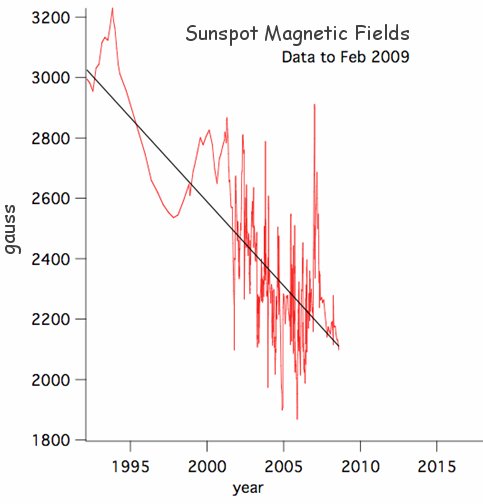Even in the midst of our current cycle, solar physicists were predicting a long minimum, and, humorously, seemed evenly divided over whether this meant we would have a more active Maximum, or a far less active Maximum. For example, David Hathaway in the NASA article "Solar Cycle 25 peaking around 2022 could be one of the weakest in centuries" clearly predicts the latter.
Recently, there have been articles about the dearth of sunspots and the extended solar minimum we are in, such as this Sept 3 2009 NASA feature, "Are Sunspots Disappearing?":
The sun is in the pits of the deepest solar minimum in nearly a century. Weeks and sometimes whole months go by without even a single tiny sunspot. The quiet has dragged out for more than two years, prompting some observers to wonder, are sunspots disappearing?"Personally, I'm betting that sunspots are coming back," says researcher Matt Penn of the National Solar Observatory (NSO) in Tucson, Arizona. But, he allows, "there is some evidence that they won't."
Penn's colleague Bill Livingston of the NSO has been measuring the magnetic fields of sunspots for the past 17 years, and he has found a remarkable trend. Sunspot magnetism is on the decline
We'll call where we are the Colaninno Minimum, for historical reasons. The Maunder Minimum was a period from 1645 to 1715 that was an extended solar minimum, featuring at times 1/1000th the usual number of sunspots. It coincided with the "Little Ice Age" that swept Europe and North America, making it the first climate debate controversy. Do extended Solar Minima imply ice ages? Are we doomed, dooooooomed! *Ahem*, back to the story.
Around 2006, solar physicist Robin Colaninno described the current minima as both extended and unusual, both similar to the Maunder Minimum (in that it's longer than usual in the Cycle) but also being quite different (in that it won't be the exact same length, nor have the same climate effect). In essence, she predicted our current anomalous minima. She had sound physical reasons for her analysis-- as I've noted, the topic of an extended Minima has been a big issue in the solar physics community.
It is for this reason I call our current dip in the solar cycle the Colaninno Minima. However, I admit there's a bit of Pascal's Wager in this. The Wager says, in short, "believe in God. If you're right, you'll get admitted into Heaven. If you're wrong, you didn't lose anything. But if you were to bet against God and be wrong, the cost is Hell itself."
I've often asserted that science is about prediction, not just 'facts'. Right or wrong, you need to predict something, then test. That's how science works-- it is a tool for connecting cause and effect. So it is better to make a prediction that may end up incorrect, than to refuse to commit and never be right.
So I'll let you and the scientific community decide. The current Colaninno Minima-- predicted years ago by a bright young solar physicist, or just a Wager that something unusual was going to happen?
Alex, the Daytime Astronomer
See also The Satellite Diaries, the diary of building our personal satellite.






Comments